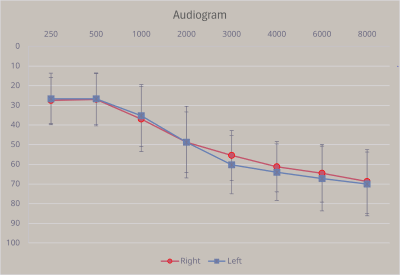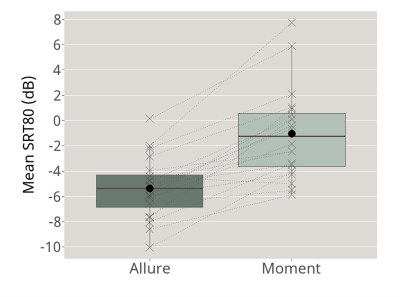Learning Outcomes
After this course learners will be able to:
- Identify differences between high and low processing delay.
- Identify potential improvements of speech intelligibility in noise with directional microphones.
- Discuss the disadvantages of the comb-filter effect.
Introduction
In 2020, Widex introduced the Moment hearing aid with the PureSound™ program featuring ZeroDelay™ technology. PureSound was designed to provide the lowest possible signal-processing delay and was shown to provide less than half a millisecond (ms) mean processing delay (Balling et al. 2020). This technological approach supports the Widex philosophy of maintaining natural sound quality by staying as close as possible to the original signal and avoiding the artifacts that may arise due to signal processing delay.
Longer processing delays can create a comb-filter effect with open-fit hearing aids. This arises because the sound following the direct pathway through the ear canal mixes with the delayed, processed sound. This mixture creates signals that are not in phase with one another, and, consequently, the sound is distorted. This distortion is more audible for people with milder degrees of hearing loss (Stiefenhofer 2023). The typical signal processing delays in hearing aids are in the range from 5 to 8 ms (Balling et al. 2020) and the literature has indicated that delays less than 10 ms can be deemed acceptable (Dillon 2012). However, delays above 1 ms are clearly audible to listeners with mild and moderate hearing losses (Stiefenhofer 2023) and this user group also prefers the sound quality of ultra-low delay (Balling et al. 2020; Lelic et al. 2022). The 0.5 ms delay of the Widex Moment PureSound program is optimal for addressing the comb-filter effect and providing a natural sound quality.
Providing improved sound quality with ultra-low delay is one approach to helping those with hearing loss. It may also contribute to improving difficulties with hearing in noise, the primary complaint associated with hearing loss (Picou 2022), by reducing cognitive effort in decoding the speech signal as well as maintaining the temporal speech envelope (Slugocki et al. 2020; Zhou et al. 2024). These potential effects are related to the neurological processing of the sound.
A popular and successful method of addressing speech intelligibility in noise has been the use of directional microphones. Directional microphones can help suppress noise from the rear field while maintaining gain for target sounds from the front field. By reducing the background noise, directional microphones can improve the signal-to-noise ratio (SNR), which can help improve speech intelligibility. However, one concern with directional microphones is that they can increase processing delay, which could lead to artifacts and reductions in perceived sound quality.
Widex has recently introduced a new hearing aid platform with the Allure hearing aid. The Allure platform includes the Widex PureSound program with ZeroDelay, providing sound quality that is optimized for open and vented fittings, for which longer processing delays would create audible artifacts. Additionally, Allure introduces directional microphones to ZeroDelay technology. The directional microphones are uniquely designed to keep processing delay low, while still effectively providing directional benefit. In this way, Allure provides high processing speed without the notable delay typically associated with directional microphone technology. The combination of low processing delay and directional microphones means that Allure can provide optimal sound quality and at the same time address competing background noise. In this study, we address two primary questions.
- Does the directional processing utilized in Allure PureSound provide improved speech intelligibility in noise for hearing aid wearers?
- Does Allure PureSound with its directional technology provide the same sound experience as other products with ZeroDelay processing?
Methods
Participants
Twenty experienced hearing aid wearers (8 female, 12 male) participated in the study. Participants were aged 42 to 79 years (mean age 68 years). Figure 1 shows the mean audiogram with +/-1 standard deviations for left and right ears.

Figure 1. Mean audiogram for participants with +/- 1 standard deviations.
Test Devices
Participants were tested with two hearing aid conditions. One pair of hearing aids was the new Widex Allure hearing aids with directional microphones activated in the PureSound program. The other pair of hearing aids was the Widex Moment hearing aids, which do not use directional technology for the PureSound program. All patients were initially fitted with Widex Allure hearing aids. The PureSound program was selected for each pair of devices. Participants were fitted to the proprietary Widex fitting formula for the new Allure devices. However, audibility within 5 dB of NAL-NL2 targets was verified via probe mic measurements. Moment hearing aid output was matched to within 2 dB of the Allure devices for 65 dB and 55 dB input levels in a 2cc coupler.
Test Materials
US English Matrix Test
The US English Matrix Test is an adaptive speech-in-noise test. Target sentences are comprised of five-word sentences selected from a closed set of words. Target sentences are presented in the presence of background noise. Participants are asked to repeat back each word in the target sentence. Participants are asked to guess if uncertain about a word. The background noise level is increased after correct responses and decreased after incorrect responses. In this modified version, the participant’s score is determined as the SNR at which 80% (SRT80) accuracy is achieved in repeating back the words from the target sentences.
For this Matrix test setup, target speech was presented from the front (0° azimuth). Target test sentences consisted of female Matrix sentences presented in an adaptive manner, beginning at a 0 dB SNR. Competing background noise was presented from 135°, 180°, and 225° azimuths. Competing noise consisted of different female Matrix sentences, continuous and uncorrelated, presented simultaneously from all three speakers. Cafeteria noise was presented along with the competing speech sentences in order to mimic a somewhat realistic difficult scenario of hearing speech in noise. The total presentation level for the competing noise was 65 dBA.
Participants completed one unaided training trial to familiarize themselves with the test. Testing with the devices was then conducted in a randomized manner. Participants completed two trials with each pair of devices.
Sound Quality Questionnaires
Sound quality questionnaires were designed to achieve ratings for a selection of recorded sound samples. The ten sound samples consisted of three categories: Speech sounds, Environmental sounds, and Music. The speech sounds included three separate recordings: female speech in quiet, male speech in quiet, and male speech in noise. For the environmental sounds, four samples were selected: bells ringing, rainfall on an umbrella, birds chirping, and water poured into a glass. For the music category, three styles of music were selected: classical, rock, and soft rock. All recordings were presented at a listening level self-adjusted for comfort from 0° azimuth. For each pair of hearing aids, each recording was presented for fifteen seconds. Following each presentation, the participant was asked “How would you rate the sound quality of the recording?” Sound quality ratings were done on 11-point Likert scales ranging from zero to ten with increments of one. The selection anchors were “Very poor sound quality” (zero) and “Very good sound quality” (ten).
Following the presentation of all ten sound samples, participants were asked to rate their listening experience with the hearing aids across all sound samples using the following questions:
- In general, how would you rate the sound quality across all recordings?
- In general, how natural do you find the sound with these hearing aids?
- In general, how clear do you find the sound with these hearing aids?
- In general, how satisfied are you with the sound of these hearing aids?
The same 11-point Likert scales were used with anchor points relevant to each question.
Results
Participants completed two Matrix test trials for each pair of devices. The mean result of the two trials was recorded as the score for each participant. For the Widex Moment devices, the mean SRT80 was -1.05 dB. The mean SRT80 for the Widex Allure devices was -5.35 dB. The lower SRT80 indicates better speech recognition in noise. Figure 2 summarizes the SRT80 results for all participants with the Allure and Moment devices. The difference between devices indicates a 4.3 dB improvement with the Widex Allure directionality in the PureSound program over the Widex Moment PureSound program. This advantage for Allure PureSound is highly significant on a Wilcoxon signed-rank test (V = 1, p < 0.0001).

Figure 2. SRT80 results for Allure and Moment hearing aids in the PureSound program. The plot shows the mean SRT80 for each hearing aid with the large black dots that indicate a -5.35 dB SNR for the SRT80 for Allure PureSound and a -1.05 dB SNR for the SRT80 for Moment PureSound. The boxes show the 25th and 75th percentiles with the median (50th percentile) represented by the line. Individual crosses connected by dotted lines represent individual participants and indicate an SRT80 advantage for Allure PureSound for 19 out of 20 participants.
Turning to the sound quality ratings, the ratings for the ten individual sound samples were grouped into their respective categories of Speech, Environment, and Music. Mean ratings for Allure and Moment for each of the sound categories are shown in Table 1. There was no significant difference between mean ratings for Allure and Moment devices. For the four questions related to the overall sound quality in the categories of Quality, Naturalness, Clarity and Satisfaction, mean ratings are also shown in Table 1. In all cases, the Allure ratings were slightly higher than the Moment ratings, though the difference was only significant for the category of Clarity (Wilcoxon signed-rank test V = 96, p-value = 0.035).
Category | Allure | Moment | p-value |
Environment | 7.69 | 7.61 | 0.6 |
Speech | 7.23 | 7.02 | 0.3 |
Music | 7.66 | 7.29 | 0.19 |
Sound Quality | 7.98 | 7.55 | 0.08 |
Naturalness | 8.13 | 7.38 | 0.09 |
Clarity | 8.18 | 7.58 | 0.03* |
Satisfaction | 8.25 | 7.65 | 0.07 |
Table 1. Mean ratings for sound categories for Allure and Moment and p-values. * indicates significance at p < 0.05.
Discussion
In this study we evaluated the speech-in-noise difference between the original PureSound program in Widex Moment, which uses an omnidirectional microphone, and the Widex Allure PureSound, which operates with a new directional microphone. Additionally, participants rated the sound quality of the PureSound programs in both devices for the categories of Speech, Environmental sounds, and Music.
For the speech-in-noise performance, the Allure PureSound program showed a 4.3 dB improvement in SNR for the SRT80 over the Moment PureSound program. This type of result is not surprising considering that directional microphones have consistently demonstrated improvements for speech intelligibility in noise over omnidirectional microphones. What makes this performance notable is that, with the additional processing of noise undertaken with a directional microphone, there is a risk of increasing processing delay. However, the PureSound program in Allure using a directional microphone achieves essentially the same ultra-low delay as the Moment using an omnidirectional microphone. The addition of the directional microphone technology to ZeroDelay processing clearly provides a benefit of reducing the competing background noise for the wearer without compromising the benefits of low delay processing.
The sound quality ratings of the two PureSound programs were also not surprising. In all three sound categories, there was no significant difference in the ratings between the devices. For the four general questions on overall Sound Quality, Naturalness of the sounds, Clarity of the sounds, and overall Satisfaction with the devices, only Clarity showed a significantly higher rating for Allure compared with Moment. This result can likely be attributed to overall improvements with the Allure platform over the Moment platform rather than the PureSound program specifically. Importantly, with regard to PureSound, these results demonstrate that the introduction of additional advanced processing gives a speech intelligibility benefit without adding delay or compromising the sound quality.
Speech intelligibility in background noise is a common concern for people with hearing loss. Low delay processing without the comb-filter effect can help the brain to better manage speech understanding in the presence of noise. Another proven method for improving speech intelligibility in noise is directional microphone technology. However, directional microphones have historically increased processing delay in hearing aids. With the Widex Allure PureSound program, there is now an option to combine directional microphone technology with the benefits of low delay processing. As seen in this evaluation, wearers can experience the improvements provided with the directional microphones without compromising sound quality.
References
Balling, L.W., et al., Reducing hearing aid delay for optimal sound quality: a new paradigm in processing. Hearing Review, 2020. 27(4): p. 20-26.
Stiefenhofer, G., Hearing aid delay in open-fit devices - coloration-pitch discrimination in normal-hearing and hearing-impaired. Int J Audiol, 2023. 62(5): p. 424-432.
Dillon, H., Hearing Aids. 2nd edition. 2012, New York, NY: Thieme Medical Publishers.
Lelic, D., et al., Hearing aid delay in open-fit devices: Preferred sound quality in listeners with normal and impaired hearing. JASA Express Lett, 2022. 2(10): p. 104803.
Picou, E.M., Hearing Aid Benefit and Satisfaction Results from the MarkeTrak 2022 Survey: Importance of Features and Hearing Care Professionals. Semin Hear, 2022. 43(4): p. 301-316.
Slugocki, C., et al., Neural Encoding of the Stimulus Envelope Facilitated by Widex ZeroDelay Technology. Hearing Review, 2020. 27(8): p. 28-31.
Zhou, M., et al., Hearing Aid Delay Effects on Neural Phase Locking. Ear Hear, 2024. 45(1): p. 142-150.
Citation
Weber, J. & Branda, E. (2025). Improved speech intelligibility in noise with ultra-low delay. AudiologyOnline, Article 29261. Retrieved from https://www.audiologyonline.com



